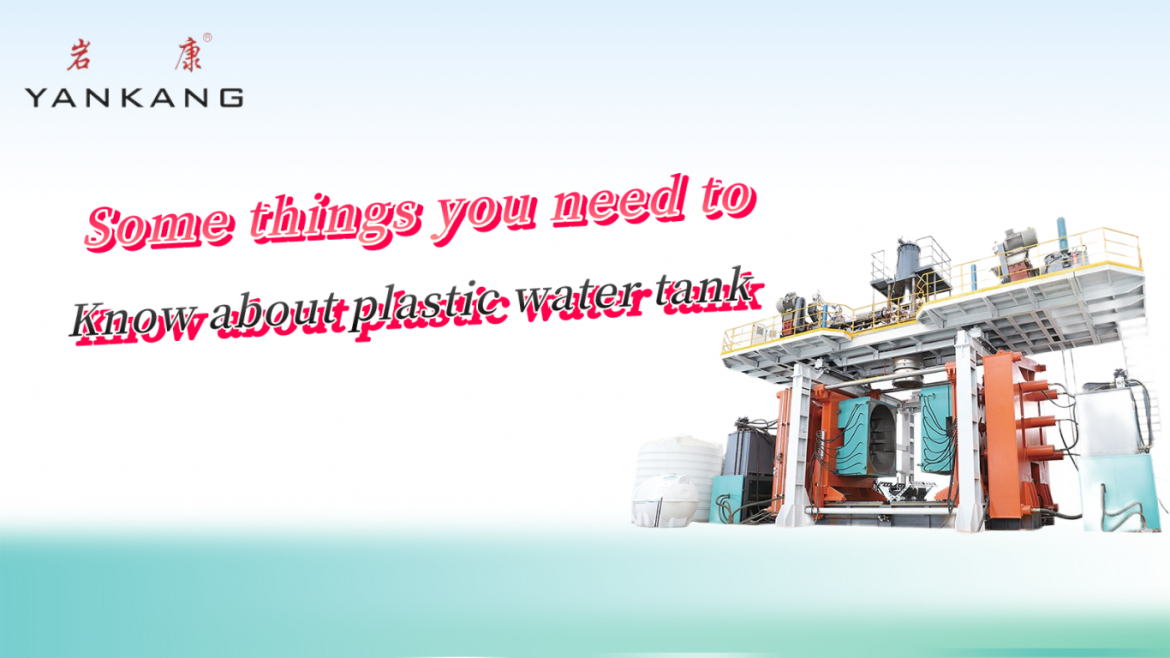The plastic water tank is the product of an extrusion blow molding machine. In the old days, people used to walk miles to get water from the well. But with the rapid advancement of technology and industrialization, new machines and products are emerging. Now let’s learn something about plastic water storage tank.
- What is a Plastic Water Tank
Water tank, just as its name implies, is a container for storing water. It’s available in a variety of models, capacities, and sizes to fit different storage spaces. For people who live far away from water, it is necessary to store water.
One advantage that Plastic Tanks have over storage tanks made from steel or concrete is much lighter weight. It means lower costs and greater ease of transport and installation. The most important one is that plastic can better withstand the force of expansion if the water tank freezes, but metal is more likely to crack.
Plastic water tanks can be manufactured from a variety of materials, the most common of which is HDPE. The plastic barrel is one-time molding and doesn’t have any joints or seams. The leading advantages of this plastic barrel include non-leakage, non-toxic, lightweight, anti-aging, impact, corrosion resistance, and long service life, etc. Most plastic tanks can last 5-10 years, depending on whether they are exposed consistently to the sun or not.
- How Plastic Water Tanks are Made
Plastic tanks are usually made via either extrusion blow molding or rotational molding. In the water tank manufacturing process, the process of extrusion blow molding is extremely simple.
Granular plastic raw materials are heated and melted at high temperature in a screw extruder. The tubular parison is extruded from the die head and placed in the cavity of the hollow blow mold. After closing the mold, the compressed air is injected into the mold immediately, so that the plastic parison is inflated and sticks to the inner wall of the mold. After cooling and demoulding, plastic water tanks are produced.
Here is an extrusion blow molding products video. You will intuitively understand how plastic water tank is made in the factory. The whole molding process is fast and full.
Compare with extrusion blow molding, there are some limitations of rotational molding. First, raw materials require additional time and technology to be ground into powder and excellent thermal stability, instead of the granular material used for blow molding. The cost of grinding the material into a powder is too high, and some water bucket shapes are difficult for rotary molding.
Second, the mould must be repeatedly subjected to alternating changes of high and low temperature while rotating on multiple axes, which can result in high energy resource consumption.
Third, the processing cycle is quite long. It usually takes about 30 minutes to 1 hour to complete the process depending on the size of the tank, but a blow molding machine can produce a water tank in 5-10 minutes.
At last, rotational molding is not achieved fully automatic control like blow molding, which usually needs labor to finish the process.
- Types of Plastic Water Tanks
From its capacity to the size, from the shape to the number of layers, from the protection it provides to the color, there are several things to consider while purchasing a plastic water tank.
Water barrel capacities can range from 25 gallons(200 liters) to 52,000 gallons(20000 liters). In addition to different capacity ranges, the shapes of the water tank are also different. plastic (polyethylene) water storage barrel can come in just about any shape you can imagine: round, rectangular, cylindrical, oval-shaped, and slimline tanks.
Such as Vertical Plastic Water Tanks, Horizontal Plastic Water Tanks, Plastic Loft Tank, Septic Tank(Underground Water Tank), and rainwater tank. These are general-type tanks and are mainly used to store water.
There are double-layer and triple-layer water tanks on the market, and Yankang Plastic Machinery can produce 200-30000L,1-8 Layers large size blow molding machine. It can be used to produce 200L-30000L vertical and horizontal water tanks. The multiple layers of the tanks help prevent UV rays from penetrating the tanks.
The anti-rusting property of plastic water tanks prevent them from degrading chemicals. They are called acid and alkali-resistant water tanks, For instance, IBC tank and double-ring chemical tank, mainly for high-temperature liquids, chemicals, strong acid, and alkali liquids.
Water storage tanks come in all capacities, sizes, shapes, durability, and strength, and just about any color that you could choose.
- Plastics for making plastic water tanks
The most widely used material for manufacturing water drums is thermoplastic. Some of the most common types of plastic materials used to produce water drums are Polyethylene(PE) and polypropylene(PP). Then which material is best for a plastic water storage drum?
The best choice is high-density polyethylene(HDPE), a light, chemically-resistant thermoplastic. They have high durability and strength and can be used longer.
In addition, if the water in the tank is intended for drinking, the plastic material needs to be food-grade. A question is: How to keep the water in a plastic storage tank from freezing? One of the best and cheapest ways is to wrap thermal insulation cotton to achieve the purpose of insulation for plastic buckets. Insulated cotton is a kind of non-toxic, harmless, pollution-free new thermal insulation material.
- Applications of Plastic Water Tanks
A water tank is not just for holding water as a home emergency water storage. Water tanks can be used for several purposes.
♦ Drinking Water
♦ Irrigation Agriculture
♦ Fire Suppression
♦ Chemical Manufacturing
♦ Wastewater Treatment
Plastic water buckets are used in various fields based on different liquid accommodation needs. We use water collected in the buckets to help us with our daily activities. Common uses for the purposes: washing cars, flushing the toilet, and watering yards, gardens, and crops. Is it not the efficient use of water resources?

